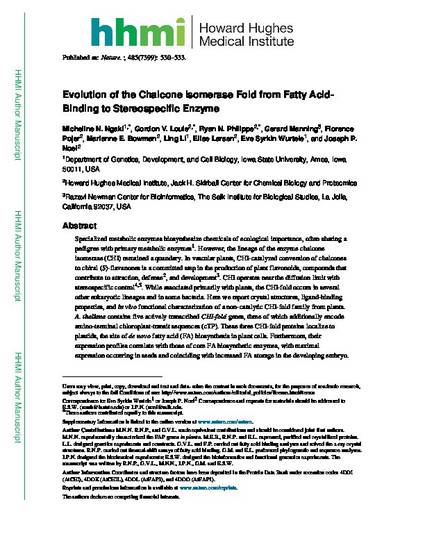
Article
Evolution of the Chalcone Isomerase Fold from Fatty Acid-Binding to Stereospecific Enzyme
Nature
Document Type
Article
Disciplines
Publication Version
Published Version
Publication Date
1-1-2012
DOI
10.1038/nature11009
Abstract
Specialized metabolic enzymes biosynthesize chemicals of ecological importance, often sharing a pedigree with primary metabolic enzymes1. However, the lineage of the enzyme chalcone isomerase (CHI) remained a quandary. In vascular plants, CHI-catalyzed conversion of chalcones to chiral (S)-flavanones is a committed step in the production of plant flavonoids, compounds that contribute to attraction, defense2, and development3. CHI operates near the diffusion limit with stereospecific control4,5. While associated primarily with plants, the CHI-fold occurs in several other eukaryotic lineages and in some bacteria. Here we report crystal structures, ligand-binding properties, and in vivo functional characterization of a non-catalytic CHI-fold family from plants. A. thaliana contains five actively transcribed CHI-fold genes, three of which additionally encode amino-terminal chloroplast-transit sequences (cTP). These three CHI-fold proteins localize to plastids, the site of de novo fatty acid (FA) biosynthesis in plant cells. Furthermore, their expression profiles correlate with those of core FA biosynthetic enzymes, with maximal expression occurring in seeds and coinciding with increased FA storage in the developing embryo. In vitro, these proteins are Fatty Acid-binding Proteins (FAP). FAP knockout A. thaliana plants exhibit elevated alpha-linolenic acid levels and marked reproductive defects, including aberrant seed formation. Notably, the FAP discovery defines the adaptive evolution of a stereospecific and catalytically ‘perfected’ enzyme6 from a non-enzymatic ancestor over a defined period of plant evolution.
Copyright Owner
The Authors
Copyright Date
2012
Language
en
File Format
application/pdf
Citation Information
Micheline N. Ngaki, Gordon V. Louie, Ryan N. Philippe, Gerard Manning, et al.. "Evolution of the Chalcone Isomerase Fold from Fatty Acid-Binding to Stereospecific Enzyme" Nature Vol. 485 Iss. 7399 (2012) p. 530 - 533 Available at: http://works.bepress.com/eve-wurtele/43/

This is a manuscript of an article from Nature 485 (2012): 530, doi: 10.1038/nature11009. Posted with permission.